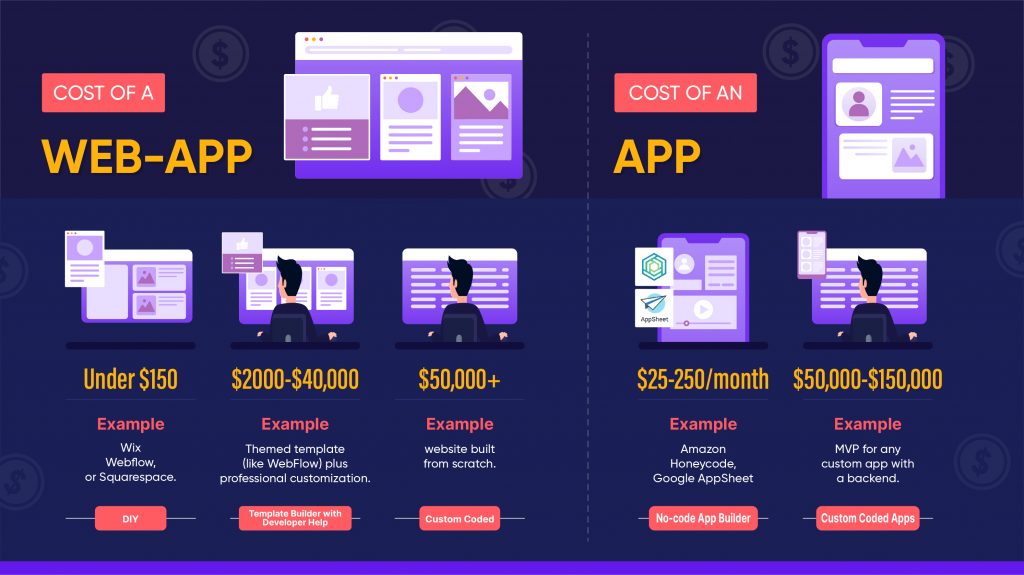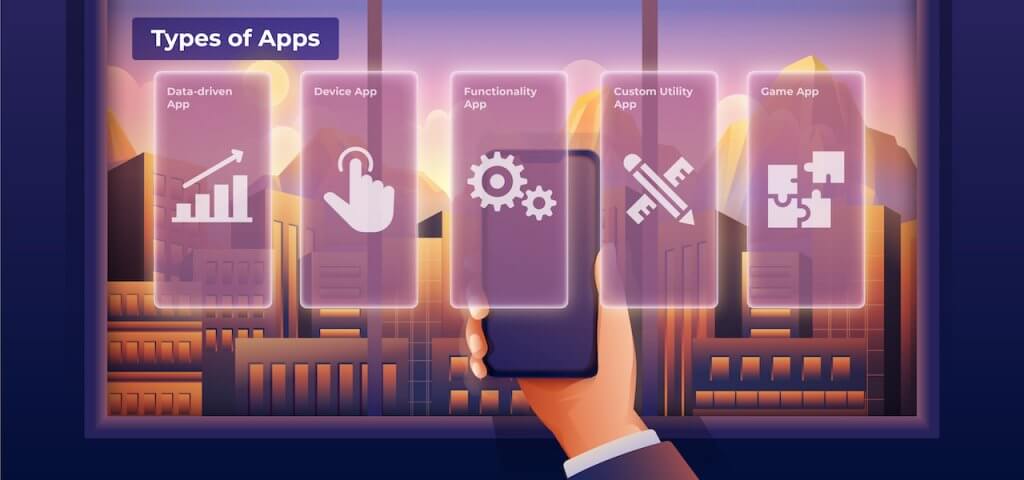App Builder Review: Appy Pie vs. Bubble vs. GoodBarber vs. BuildFire
Using an app builder has some advantages, but builders aren’t suitable for all apps. Here’s what you need to know about using an app builder, when...

When asking how much does it cost to build a mobile app, you’ll likely get the answer, “it depends”. There are numerous variables that can impact app development cost, including features, what platform(s) or device(s) you are building for, and the level of ongoing maintenance that will be required. Trying to determine a budget for building an app can be frustrating. In this post, we walk you through the things you need to know to answer the question, “How much does it cost to make an app?”
Estimating the cost to develop an app is like asking someone to guess how much it costs to build a car. Before you even get close to an answer, you’ll be peppered with questions like “Is this a high-end luxury car or a standard sedan?” “How powerful should the engine be?” “Is it important to have upgraded leather seats, or are standard cloth ones acceptable?”
Like car manufacturing, the cost of building apps is determined by the level of sophistication of each one of its components.
Loosely, we can estimate ballpark ranges based on app complexity:
| App Complexity | Cost | Examples |
| Simple, basic | ~$50-$60k | straightforward to-do apps, a notes app, and a countdown timer. |
| Medium | ~$100-150k | MVPs, dating app, productivity app, marketplace app |
| High | ~$200k+ | Social media app, enterprise organization app, extensive wellness tracking app |
If you need an app to do one thing well, it can likely be created cheaply, especially if it doesn’t even need custom code, you could get away with using an app builder. These are great for apps that need to do one thing, like take and save notes.
However, adding in bells and whistles, more features, and increasing the overall “polished” look of an app can quickly add up, just like how a new Ferrari quickly eclipses a 1990 Honda Civic in price. An app developer needs to know the full list of features included in order to make an accurate cost estimate.
The heavy upfront cost of building an app is also why most people settle for an MVP (minimal viable product) for their first version. Though it might not be the full dream for an app, an MVP has enough features to get user feedback on the concept. This will directly affect the price by allowing an app to be built cheaper in its first version, as a lot of features are delayed for later iterations. If you’re on a tight budget, starting with an MVP can help stretch your dollars.
If you begin with an MVP, you’re likely to spend about $50,000-$150,000 depending on your needs. “Building the dream” app would likely be four times this amount. If you plan to take your app to the level of the major players we know of today, that would be just a fraction of the overall cost. For example, Strava—the popular running and workout tracking app—has gone through multiple funding rounds raising $150 million in funding, to qualify it for unicorn status in Silicon Valley. Though most apps are obviously not that expensive, it’s worth noting how far the scale can go.
While developer rates can vary based on skill set and experience, a handful of primary factors significantly influence the cost to build an app.

One of the first decisions you will need to make is whether you want to build a mobile app or a web app. Mobile apps run on a specific operating system like Android or iOS. Web apps are responsive websites that launch in a computer browser or a mobile device browser. Web apps are cheaper to make. However, they don’t take advantage of device features like phone or GPS, and they require WIFI or cellular data access.
Determining the tradeoff between cost and functionality will depend on the requirements of your app. For example, if you’re building an app that requires the use of a phone or tablet’s camera or requires downloads, you will want to consider a mobile app over a web app. If budget is a primary driver and you don’t need the device functionality, starting with a web app may make more sense.
Web-apps can range from a few basic pages serving marketing text or imagery to full-on global marketplaces. Most people start out simple with their website and expand as their product grows, which leaves a few options for that first version.
Apps cost more in comparison to websites and progressive web-apps. Generally, there is more code work that is needed to create an app. Even if integrations are used to help save time by not reinventing a feature like a messaging system, implementing that prebuilt feature into the app requires a lot of effort. Though app development is getting faster all the time, its labor-intensive nature means the lower end cost to build an app is still pricey.
If you decide you want to build a mobile app, you then have another decision: native or hybrid. It’s essential to do your research to make this choice. Are your target users more likely to reach for an Android or an iOS product? The answer may depend on the market(s) where you plan to sell your app. Do you need to consider building on both?
Choosing one platform to focus on for an MVP can help reduce costs when developing an app. Instead of paying for both an iPhone and Android release, choosing just one could cut your product budget in half. Whereas an Android/iPhone app launch might cost $100,000, releasing the app only to Apple could bring your initial investment down to $50,000.
You also have the option to do a hybrid build, using one code set for both Android and iOS operating systems. While this option may seem a great compromise and is more efficient in terms of the development effort and ongoing maintenance, there are some sacrifices. You may experience lower performance and usability issues if the app makes use of specific device functionality. Depending on your app’s complexity, it may still require some coding for each operating system, even with a hybrid approach.
However, cross-platform code bases such as Flutter have made leaps and bounds in improvements since they were first released. If you know you want to have an app that both Apple and Android users can download and use, it often saves costs overall to start with developing one set of code in order to deploy the app on both operating systems. An MVP hybrid app could start around $40,000, but a fully-fledged first release can also begin in the $100,000-$200,000 range.
A native development approach, where you build an app specifically for an operating system, means a better user experience. But it does come at a higher cost since you are doing a separate build for each operating system (although graphics and some code can be reused).
Learn more: 11 Best Mobile App Programming Languages

Not every app needs every step in the process. Some projects might only need some frontend design work and simply want some mobile screen mockups to use for fundraising. Other projects might have concept art ready to go and only need the development code plumbed out.
Often new projects will begin with separate UI (user interface) and UX (user experience) scopes and sprints. Beginning with frontend design, then moving on to development, can cut down on the number of times a feature needs to be scrapped or rewritten. UI work itself is significantly cheaper than UX, due to how it’s created.
UX development is when the nicely formatted designs become clickable, tappable, and usable. It’s easy to draw a Mercedes on a piece of paper, but a lot harder to build one. UX work takes a lot longer as it’s coding the platform in its entirety, so there is an inherent cost of needing to spend more for developers’ time.
Example:
600 hours of cross-platform coding
+ 400 hours for server API development
+ 180 hours for an Admin Panel
+ 30 hours to update design work
——————————————————————
= approx $180,000 in development costs to build an app
After going through all of the design, then all sprints in development, standard practice is to allow time for a beta testing phase. This can include a soft launch of the app, such as releasing it to a small audience of invite-only users. Controlling the release allows user testing to occur and provides quality assurance and feedback on the system. Developers can then fix any bugs in the code easily before it’s released to the general public.
Should the app need monthly maintenance at 10 hours/month to keep the platform health high, then that would be another ongoing cost of $1,500/month baked into the overall expense to build an app.
Here are some of our top choices for remote usability testing tools.
The nature of the app you plan to build will also impact the resources it takes to make it. This includes both the type of app and the features and functionality it will require. The two are intertwined since the type of app will drive some of the features.
There isn’t a standard list of app types, but you can categorize them by what they’re designed to do. For example, are you creating a social networking app or a gaming app? Or a data-driven app? Identifying the type of app will give you a better understanding of the level of complexity required to build it and the integrations it will require.
You’ll also want to take a look at the functionality needed to get an understanding of app cost. Will your app require download capability, and access to device features? Is there a login function with the security required? Is encryption necessary for payments? How about chat or push notifications? You’ll need to consider all of the functionality and complexity to determine the cost.
Simple features, like allowing users to block and unblock other users, can be done in 4 hours of a developer’s time. On average, in the U.S., people can expect to pay rates of about $150/hr for development work.
For more complex features, such as needing to include a way to pay and receive money, could take upwards of 40 hours to integrate a third-party system. If the payment portal needs to be custom coded, you’re looking at over 100 hours, not even including if there is a need for an internal tracking ledger to be created.
It cannot be overstated how much effect specific features and needs of an app will change its overall price tag. And even using third-party API integrations and SDKs to get around the hours needed to custom code complicated features, these platforms likely come with their monthly fee, which could add up if using a lot of them.
Here are some more examples of what various features cost:
| Feature | Hours Needed to Develop | Cost (at $150/hr) |
| Sign in with Email/Password | 4 | $600 |
| The ability for a fitness teacher to add a new class and fill out info about it | 12 | $1,800 |
| Backend ability to see uploaded videos and images | 8 | $1,200 |
| Showing a list of new notifications within the app | 16 | $2,400 |
| Posting a new item in a marketplace app | 15 | $2,250 |
| Allowing backend user management | 40 | $6000 |
Software can get very “big,” very fast. Asking a consultant or company to help you create a line item feature estimate for your idea will go a long way in providing an accurate cost of making an app.
In addition to the cost of developing the app, you should also consider ongoing costs for support. You’ll need to pay app hosting costs, and possibly vendor fees for integrations as well as app store fees and app maintenance costs.
Another ongoing cost is the development of new features and improvements. If you’re building an MVP, you’ll want to iterate development to integrate customer feedback to improve the product. Chances are, you’ll have an estimated cost to build the app, and then ongoing app costs to develop later versions with additional functionality.
Below are some common ongoing expense examples that can help you estimate the total of how much it might cost to develop an app:

You may think you’re done when you’ve outlined what the app will require for the first four factors. However, there is another to consider — hidden costs. Based on the desired functionality, what infrastructure is necessary to support it? What about encryption or integration with external tools through APIs? Is there a need for a database to store and retrieve data and files? All of these can be factors you may initially overlook when determining the cost of developing an app.
Guessing at the needs here can quickly become a rabbit hole, as there is always a cheap option and an expensive option. For example, all apps require a privacy policy in order to be accepted by Apple and Google in their stores. Straightforward apps that don’t cater to sensitive populations or topics that are heavily regulated can probably get by using an online privacy policy generator for a small one-time fee of $30-$50.
But what if the app is a game for children? There is a lot more regulation around allowing an app to get approved and labeled with the “kids” tag in an app store. To qualify, that privacy policy will need to be much more robust, which might require the advice of a specialty lawyer. Suddenly, that $20 privacy policy will cost at least a couple hundred dollars.
Costs will also range based on both the size of the development company and its expertise. You want to look for a developer with a proven track record who has demonstrated experience. Check out their portfolio and ask questions about their involvement with the work. Your developer should partner with you and make recommendations based on their experience. A good developer will also understand business and be able to make recommendations that make good business sense.
Though the price tag someone gives you for developing an app doesn’t necessarily equate to quality, there are a few pros and cons of various app developer options when related to development cost.
Hiring a freelancer means finding someone who isn’t attached to a single development company but can offer their skills.
There are many companies out there that specialize in developing apps, which are a great way for someone to hand off their idea to a professional.
These are companies with many employees, maybe their own development teams, that focus on app creation.
Hiring a team of developers is always a possibility, just not feasible, as you’ll likely need at least 2-3 developers for 6 months. For someone starting, this would be an incredibly large commitment from the outset, especially if unsure about the product’s viability.
At its most basic level, the cost to build an app is Hours of Developer Time x Hourly Rate. However, it’s not quite that simple. Experienced product designers will ensure you have a strong MVP plan that can be proven in the marketplace. And experienced developers will ensure that you don’t waste resources by having to go back and rebuild sloppy code. Once you’ve eliminated the risks associated with working with inexperienced partners, what can you expect to spend on different types of apps with different functionality?
Here are some ranges of what you might expect:
| App Type | Cost | Timeline | Examples |
|---|---|---|---|
| Basic Utility App | ~$15,000 | ~1-2 months | Calculations, clocks, information stored locally on phone |
| App with External Database | ~$50,000 | ~2-3 months | Information pulled from an outside source (or dynamic database) to be displayed in the app: stocks, weather, etc. |
| Social Network App | ~100,000 – $150,000 | ~4-5 months | Facebook, Instagram, LinkedIn |
| Marketplace App (Buyer/Seller Interactions) | ~$125,000 – $175,000 | ~5-6 months | AirBnB, Uber, eBay |
Because of all the factors that go into determining app development cost and the technical nature of them, we recommend taking a different approach to creating a budget. You’ll get a clearer picture of costs when you speak with the team you’ll be partnering with — whether this team is internal to your company or an outsourced company like ours. First, identify who you have confidence partnering with, then work with them to construct a budget. This approach has several benefits, including ensuring you have a strong MVP concept and haven’t forgotten an essential piece of development needed.
This meeting should be a two-way conversation, as you want your developer to share recommendations that will impact your app’s success based on their expertise.
The developer should include a scope of work with your estimate, which includes all features and functionality for your app. Review this with a fine-toothed comb to make sure it includes everything you expect and all that you need. In addition to the design and development work, this scope of work should include any research that will be done, testing efforts, and third-party integration, if applicable. Also, take a look to see what is covered for post-launch maintenance and support as this can be a significant effort if you are expected to do it.
The estimate shared with you should include all of the costs associated with the scope of work. Ideally, the estimate should break out the work by feature so you can evaluate for prioritization should you need to make adjustments. If the developer will use a third-party product or service, they should detail as well.
How much does it cost to build an app? The unfortunate answer is: it depends. But arming yourself with the knowledge of what can cause the largest variances in cost will serve you well. And when you know what to expect in an estimate and what to look out for, you can make a better decision about who you want to partner with to build it.
In our SolutionLab workshop, we help you identify the functionality you need for a successful MVP and give you a roadmap that will keep you on track during development. Want to learn more? Get in touch and we’ll schedule a call.
You might also like:
Subscribe to our newsletter.

Using an app builder has some advantages, but builders aren’t suitable for all apps. Here’s what you need to know about using an app builder, when...

Mobile app or web app? It’s not always a clear decision. If you survey startup founders, you will hear strong opinions on either side. The reason for...

Once you decide to build an app, you have a choice to make: should you develop your app for iOS or Android? Many factors impact your decision,...
Post
Share